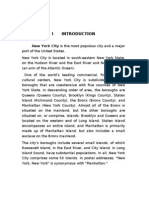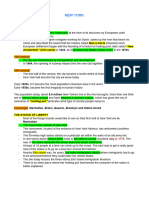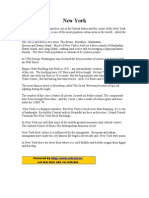0 ratings0% found this document useful (0 votes)
39 viewsStudent: Marin Gabriela Adviser: Mrs. Florina Ruse
Student: Marin Gabriela Adviser: Mrs. Florina Ruse
Uploaded by
Luminita LumyThis document provides an overview of New York City, covering its history, geography, climate, environment, architecture, parks, culture, tourism, cuisine, and media. Some key points include:
- New York City was originally inhabited by Native Americans and was later settled by the Dutch as New Amsterdam in 1614. It grew to become one of the most important cities in the world.
- The city has a humid subtropical climate with hot, humid summers and cold winters. Its location on islands at the mouth of the Hudson River fed its growth as a trading hub.
- New York is known for its iconic skyscrapers and has more high-rise buildings than any other US city. The city also has
Copyright:
© All Rights Reserved
Available Formats
Download as PPTX, PDF, TXT or read online from Scribd
Student: Marin Gabriela Adviser: Mrs. Florina Ruse
Student: Marin Gabriela Adviser: Mrs. Florina Ruse
Uploaded by
Luminita Lumy0 ratings0% found this document useful (0 votes)
39 views17 pagesThis document provides an overview of New York City, covering its history, geography, climate, environment, architecture, parks, culture, tourism, cuisine, and media. Some key points include:
- New York City was originally inhabited by Native Americans and was later settled by the Dutch as New Amsterdam in 1614. It grew to become one of the most important cities in the world.
- The city has a humid subtropical climate with hot, humid summers and cold winters. Its location on islands at the mouth of the Hudson River fed its growth as a trading hub.
- New York is known for its iconic skyscrapers and has more high-rise buildings than any other US city. The city also has
Original Title
filehost_1
Copyright
© © All Rights Reserved
Available Formats
PPTX, PDF, TXT or read online from Scribd
Share this document
Did you find this document useful?
Is this content inappropriate?
This document provides an overview of New York City, covering its history, geography, climate, environment, architecture, parks, culture, tourism, cuisine, and media. Some key points include:
- New York City was originally inhabited by Native Americans and was later settled by the Dutch as New Amsterdam in 1614. It grew to become one of the most important cities in the world.
- The city has a humid subtropical climate with hot, humid summers and cold winters. Its location on islands at the mouth of the Hudson River fed its growth as a trading hub.
- New York is known for its iconic skyscrapers and has more high-rise buildings than any other US city. The city also has
Copyright:
© All Rights Reserved
Available Formats
Download as PPTX, PDF, TXT or read online from Scribd
Download as pptx, pdf, or txt
0 ratings0% found this document useful (0 votes)
39 views17 pagesStudent: Marin Gabriela Adviser: Mrs. Florina Ruse
Student: Marin Gabriela Adviser: Mrs. Florina Ruse
Uploaded by
Luminita LumyThis document provides an overview of New York City, covering its history, geography, climate, environment, architecture, parks, culture, tourism, cuisine, and media. Some key points include:
- New York City was originally inhabited by Native Americans and was later settled by the Dutch as New Amsterdam in 1614. It grew to become one of the most important cities in the world.
- The city has a humid subtropical climate with hot, humid summers and cold winters. Its location on islands at the mouth of the Hudson River fed its growth as a trading hub.
- New York is known for its iconic skyscrapers and has more high-rise buildings than any other US city. The city also has
Copyright:
© All Rights Reserved
Available Formats
Download as PPTX, PDF, TXT or read online from Scribd
Download as pptx, pdf, or txt
You are on page 1of 17
Student: Marin Gabriela
Adviser: Mrs. Florina Ruse
Argument
I have chosen this thesis subject because of my fascination regarding New York
City.
Perhaps no city on earth evokes images as powerful as those associated with New
York. Its skyline and its iconsthe Statue of Liberty, Times Square, Madison
Square Garden, the Empire State Building, Yankee and Shea stadiums, the
Brooklyn Bridge, the Staten Island Ferry, Coney Island, and Grand Central
Terminalare famous throughout the world. Even the streets are symbolic
Fifth Avenue epitomizes shopping, Broadway and theater are inseparable,
Madison Avenue evokes images of advertising, Seventh Avenue is the center of
fashion, and Wall Street is synonymous with finance. As the so-called capital of
capitalism, New York has long been one of the largest and most important cities
in the world.
New York City's significance is indisputably far-reaching, long lasting, and
diverse. The city's current profile and vibrant history merit accurate recording in a
form useful to policy makers, scholars, teachers, urban specialists, and anyone
interested in this fascinating metropolis.
History
The region of New York was inhabited by about 5,000 Lenape Native Americans at the time of its
European discovery in 1524 by Giovanni da Verrazzano, an Italian explorer in the service of the
French crown, who called it "Nouvelle Angoulme" (New Angoulme). European settlement began
with the founding of a Dutch fur trading settlement, later called "Nieuw Amsterdam" (New
Amsterdam), on the southern tip of Manhattan in 1614. Dutch colonial Director-General Peter
Minuit purchased the island of Manhattan from the Lenape in 1626 for a value of 60 guilders
(about $1000 in 2006); a legend, now disproved, says that Manhattan was purchased for $24 worth
of glass beads.
Anger at military conscription during the American Civil War (18611865) led to the Draft Riots
of 1863, one of the worst incidents of civil unrest in American history.
In 1898, the modern City of New York was formed with the consolidation of Brooklyn (until then
an independent city), the County of New York (which then included parts of the Bronx), the
County of Richmond, and the western portion of the County of Queens. The opening of the New
York City Subway in 1904 helped bind the new city together. Throughout the first half of the 20th
century, the city became a world center for industry, commerce, and communication. However, this
development did not come without a price. In 1904, the steamship General Slocum caught fire in
the East River, killing 1,021 people on board.
In 1911, the Triangle Shirtwaist Factory fire, the city's worst industrial disaster, took the lives of
146 garment workers and spurred the growth of the International Ladies' Garment Workers' Union
and major improvements in factory safety standards.
The Twin Towers
The city was one of the sites of the September
11, 2001 attacks, when nearly 3,000 people
died in the destruction of the World Trade
Center. A new 1 World Trade Center
(previously known as the Freedom Tower),
along with a memorial and three other office
towers, will be built on the site and is
scheduled for completion in 2013. On
December 19, 2006, the first steel columns
were installed in the building's foundation.
Three other high-rise office buildings are
planned for the site along Greenwich Street,
and they will surround the World Trade Center
Memorial, which is under construction. The
area will also be home to a museum dedicated
to the history of the site.
Geography
New York City is located in
the Northeastern United
States, in southeastern New
York State, approximately
halfway between Washington,
D.C. and Boston. The location
at the mouth of the Hudson
River, which feeds into a
naturally sheltered harbor and
then into the Atlantic Ocean,
has helped the city grow in
significance as a trading city.
Much of New York is built on
the three islands of
Manhattan, Staten Island, and
Long Island, making land
scarce and encouraging a high
population density.
Climate
New York City has a humid subtropical climate and enjoys an
average of 234 days with at least some sunshine annually. It is
the northernmost major city in North America that features a
humid subtropical climate using the 0 C (American scientist
standard) isotherm as criteria.
Summers are typically hot and humid with average high
temperatures of 79 84 F (26 29 C) and lows of 63 69 F
(17 21 C), however temperatures exceed 90 F (32 C) on
average of 16 19 days each summer and can exceed 100 F
(38 C) every 46 years. Winters are cold, and prevailing wind
patterns that blow offshore somewhat minimizes the influence
of the Atlantic Ocean.
Environment
Mass transit use in New York City is the highest in the United
States, and gasoline consumption in the city is the same rate as
the national average in the 1920s. New York City's high level
of mass transit use saved 1.8 billion gallons of oil in 2006;
New York saves half of all the oil saved by transit nationwide.
The city's population density, low automobile use and high
transit utility make it among the most energy efficient cities in
the United States. New York City's greenhouse gas emissions
are 7.1 metric tons per person compared with the national
average of 24.5. New Yorkers are collectively responsible for
one percent of the nation's total greenhouse gas emissions
though they comprise 2.7% of the nation's population.
Architecture
The building form most closely
associated with New York City is the
skyscraper. In August 2008, New
York City had 5,538 high-rise
buildings, with 50 completed
skyscrapers taller than 656 feet (200
m). This is more than any other city
in United States, and second in the
world behind Hong Kong. New York
has architecturally significant
buildings in a wide range of styles.
These include the Woolworth
Building (1913), an early gothic
revival skyscraper built with
massively scaled gothic detailing able
to be read from street level several
hundred feet below.
Parks
New York City has over
28,000 acres (110 km2) of
municipal parkland and 14 miles
(23 km) of public beaches. This
parkland is augmented by
thousands of acres of Gateway
National Recreation Area, part
of the National Park system, that
lie within city boundaries. The
Jamaica Bay Wildlife Refuge,
the only wildlife refuge in the
National Park System, alone is
over 9,000 acres (36 km2) of
marsh islands and water taking
up most of Jamaica Bay.
Culture
Numerous major American cultural movements began in
the city, such as the Harlem Renaissance, which
established the African-American literary canon in the
United States. The city was a center of jazz in the 1940s,
abstract expressionism in the 1950s and the birthplace of
hip hop in the 1970s. The city's punk and hardcore scenes
were influential in the 1970s and 1980s, and the city has
long had a flourishing scene for Jewish American
literature. Prominent indie rock bands coming out of New
York in recent years include The Strokes, Interpol, The
Bravery, Scissor Sisters, and They Might Be Giants.
Tourism
Tourism is important to New York City, with about 47 million
foreign and American tourists visiting each year. Major
destinations include the Empire State Building, Ellis Island,
Broadway theatre productions, museums such as the
Metropolitan Museum of Art, and other tourist attractions
including Central Park, Washington Square Park, Rockefeller
Center, Times Square, the Bronx Zoo, New York Botanical
Garden, luxury shopping along Fifth and Madison Avenues,
and events such as the Halloween Parade in Greenwich
Village, the Tribeca Film Festival, and free performances in
Central Park at Summerstage.
Cuisine
New York's food culture, influenced by the city's immigrants
and large number of dining patrons, is diverse. Eastern
European and Italian immigrants have made the city famous
for bagels, cheesecake, and New York-style pizza. Some 4,000
mobile food vendors licensed by the city, many immigrant-
owned, have made Middle Eastern foods such as falafels and
kebabs standbys of contemporary New York street food,
although hot dogs and pretzels are still the main street fare.
The city is also home to many of the finest haute cuisine
restaurants in the United States. New York City's variety of
World cuisines is also diverse. Examples could include Italian,
French, Spanish, German, Russian, English, Greek, Moroccan,
Chinese, Indian, and Japanese cuisines, as well as the diverse
indigenous sort.
Media
New York is a global center for the television,
advertising, music, newspaper and book publishing
industries and is also the largest media market in North
America (followed by Los Angeles, Chicago, and
Toronto).
Some of the city's media conglomerates include Time
Warner, the News Corporation, the Hearst Corporation,
and Viacom. Seven of the world's top eight global
advertising agency networks have their headquarters in
New York. Three of the "Big Four" record labels are also
based in the city, as well as in Los Angeles.
Media
New York is also a major center for non-commercial media.
The oldest public-access television channel in the United
States is the Manhattan Neighborhood Network, founded in
1971. WNET is the city's major public television station and a
primary provider of national PBS programming. WNYC, a
public radio station owned by the city until 1997, has the
largest public radio audience in the United States.
The City of New York operates a public broadcast service,
nyctv, that produces several original Emmy Award-winning
shows covering music and culture in city neighborhoods, as
well as city government.
Conclusion
New York City's significance is indisputably far-reaching, long
lasting, and diverse. The city's current profile and vibrant
history merit accurate recording in a form useful to policy
makers, scholars, teachers, urban specialists, and anyone
interested in this fascinating metropolis.
New York is notable among American cities for its high use of
mass transit, most of which runs 24 hours per day, and for the
overall density and diversity of its population. In 2005, nearly
170 languages were spoken in the city and 36% of its
population was born outside the United States. Sometimes
referred to as "The City that Never Sleeps", the city has also
been nicknamed the Capital of the world, Gotham, and the Big
Apple.
Conclusion
The character of New York's large residential districts is often defined by
the elegant brownstone rowhouses, townhouses, and shabby tenements
that were built during a period of rapid expansion from 1870 to 1930.
Stone and brick became the city's building materials of choice after the
construction of wood-frame houses was limited in the aftermath of the
Great Fire of 1835. Unlike Paris, which for centuries was built from its
own limestone bedrock, New York has always drawn its building stone
from a far-flung network of quarries and its stone buildings have a
variety of textures and hues. A distinctive feature of many of the city's
buildings is the presence of wooden roof-mounted water towers. In the
1800s, the city required their installation on buildings higher than six
stories to prevent the need for excessively high water pressures at lower
elevations, which could burst municipal water pipes. Garden apartments
became popular during the 1920s in outlying areas, including Jackson
Heights in Queens, which became more accessible with expansion of the
subway.
Bibliography
Shorto, Russell (2005). The Island at the Center of The
World, 1st Edition. New York: Vintage Books.
Lundrigan, Margaret (2004). Staten Island: Isle of the
Bay, NY. Arcadia Publishing
Homberger, Eric (2005). The Historical Atlas of New
York City: A Visual Celebration of 400 Years of New York
City's History. Owl Books.
Lopate , Phillip (2004). Waterfront: A Walk Around
Manhattan. Anchor Press.
You might also like
- New YorkDocument23 pagesNew YorkAndrada MariaNo ratings yet
- Facade ExamplesDocument10 pagesFacade ExamplesAmro Ahmad Ali100% (1)
- Guide To Operating Systems SecurityDocument2 pagesGuide To Operating Systems SecurityshashahayesNo ratings yet
- New York City Is The Most Populous City and A MajorDocument8 pagesNew York City Is The Most Populous City and A MajorAMIonascuNo ratings yet
- New York CityDocument14 pagesNew York CityRafael CarvalhoNo ratings yet
- Inglese (Verifica)Document7 pagesInglese (Verifica)daniellamarie.mercadoNo ratings yet
- Group 16 - ScriptDocument3 pagesGroup 16 - Scripthằng TrinhNo ratings yet
- Ny DNL PDFDocument5 pagesNy DNL PDFamokraneTNo ratings yet
- New YorkDocument3 pagesNew YorkjNo ratings yet
- New YorkDocument6 pagesNew YorkAnca ANo ratings yet
- New YorkDocument13 pagesNew YorkPedro García MagroNo ratings yet
- New YorkDocument3 pagesNew YorkSORINysNo ratings yet
- New York CityDocument51 pagesNew York Citynod284No ratings yet
- New York CityDocument23 pagesNew York CityAlexandru LicaNo ratings yet
- 171014Document26 pages171014Елизавета КозловаNo ratings yet
- New York CityDocument28 pagesNew York CityMilosava MarkovicNo ratings yet
- New YorkDocument2 pagesNew YorkRonaldo MarcaNo ratings yet
- New York Travel Guide: A Comprehensive Guide to New York, USA.From EverandNew York Travel Guide: A Comprehensive Guide to New York, USA.No ratings yet
- FSI New York CityDocument34 pagesFSI New York CityDan IlieNo ratings yet
- Compunere New YorkDocument1 pageCompunere New YorkCamelia CismaruNo ratings yet
- New York City, The Five Boroughs: American Civilization (HIST 110) Lecturer: Ms JaimeDocument47 pagesNew York City, The Five Boroughs: American Civilization (HIST 110) Lecturer: Ms JaimeRy TeoNo ratings yet
- WWW - Referat.ro NewYork C7ee6Document2 pagesWWW - Referat.ro NewYork C7ee6Dede_lgNo ratings yet
- New York.Document2 pagesNew York.teresasd99No ratings yet
- New York CityDocument2 pagesNew York CityKatarina StegicNo ratings yet
- 4. the New York City, Washington D CDocument2 pages4. the New York City, Washington D Cmaton.notamNo ratings yet
- HW 7 - New York City BrochureDocument5 pagesHW 7 - New York City BrochureMo IbrahimNo ratings yet
- New YorkDocument9 pagesNew YorkЛера БлизнюкNo ratings yet
- Nju IorkDocument14 pagesNju Iorkyulia oksyutaNo ratings yet
- UntitledDocument30 pagesUntitledAlexandru LicaNo ratings yet
- 5 AmericaDocument11 pages5 Americadothihuyenhoa575No ratings yet
- New York City - Facts PPT FUN ACTIVITYDocument34 pagesNew York City - Facts PPT FUN ACTIVITYhqs17606No ratings yet
- New YorkDocument19 pagesNew YorkAnonymous IK48EE6OyANo ratings yet
- New York: Grand Central Terminal, Washington Square Park, Whitney MuseumDocument1 pageNew York: Grand Central Terminal, Washington Square Park, Whitney MuseumAntonino SciarrottaNo ratings yet
- NEW YORK CITY Power PointDocument12 pagesNEW YORK CITY Power PointjordiferrandoamorosNo ratings yet
- New YorkDocument20 pagesNew YorkМаша ГорбачNo ratings yet
- Travelling Abroad - 44Document2 pagesTravelling Abroad - 44Eduard BerneaNo ratings yet
- Нью Йорк,СШАDocument17 pagesНью Йорк,СШАanna.kolesnichenko.68No ratings yet
- Manhattan Brooklyn Bronx Staten Island: QueensDocument4 pagesManhattan Brooklyn Bronx Staten Island: QueensSouvick GhoshNo ratings yet
- Travelling Abroad 1: New York Is TheDocument2 pagesTravelling Abroad 1: New York Is TheEduard BerneaNo ratings yet
- New-York 90704Document10 pagesNew-York 90704alexandrabroca4No ratings yet
- By Isacescu Vlad: Industry and LeisureDocument5 pagesBy Isacescu Vlad: Industry and LeisureDorin YeniNo ratings yet
- New YorkDocument9 pagesNew YorkTatjana LipovacNo ratings yet
- Culture and Contemporary LifeDocument16 pagesCulture and Contemporary LifeAnca ANo ratings yet
- NewyorkDocument1 pageNewyorkAjeesh JosephNo ratings yet
- PHILOSOPHY_273_REPORTDocument4 pagesPHILOSOPHY_273_REPORT27naila2004No ratings yet
- New YorkDocument5 pagesNew Yorkzabolotnyi61100% (1)
- Usa 2Document10 pagesUsa 2Віка ВольськаNo ratings yet
- мегаполисыDocument2 pagesмегаполисыЕлена КартавцеваNo ratings yet
- PHILOSOPHY_273_REVIEWDocument3 pagesPHILOSOPHY_273_REVIEW27naila2004No ratings yet
- UntitledDocument30 pagesUntitledAlexandru LicaNo ratings yet
- Chicago City: Industry AND LeisureDocument5 pagesChicago City: Industry AND LeisureD@m@igeNo ratings yet
- 2008 MO-cc New YorkDocument9 pages2008 MO-cc New YorknovosadNo ratings yet
- AmericaDocument5 pagesAmericamastikovaz2006No ratings yet
- New YorkDocument14 pagesNew Yorkcarla.ayllonNo ratings yet
- New YorkDocument8 pagesNew YorkBartosz GrzybowskiNo ratings yet
- United States: Created By: Miron LuminitaDocument25 pagesUnited States: Created By: Miron LuminitaLuminiţaMironNo ratings yet
- New York CityDocument3 pagesNew York CityLioknulstNo ratings yet
- New York PowerpointDocument10 pagesNew York PowerpointOvidiu GeorgescuNo ratings yet
- RRU8862ADocument28 pagesRRU8862AMarco CasaranoNo ratings yet
- Stability of Earth SlopesDocument13 pagesStability of Earth SlopesNew GuyNo ratings yet
- ACN SyllabusDocument1 pageACN Syllabusसुरेन्द्र वशिष्ठNo ratings yet
- System Turnover Package List (Construction)Document9 pagesSystem Turnover Package List (Construction)Smith SuwanNo ratings yet
- Austria: Valley, Salzburg and The Sound of Music Lake DistrictDocument5 pagesAustria: Valley, Salzburg and The Sound of Music Lake DistrictPaul SchnellNo ratings yet
- ECE 452: Computer Organization and DesignDocument9 pagesECE 452: Computer Organization and Designdermeister1988No ratings yet
- Forex Finiss and Sap4.7 Config EnglishDocument19 pagesForex Finiss and Sap4.7 Config EnglishKenz SibumaNo ratings yet
- Answer These Questions by Choose Between A, B, C, or DDocument15 pagesAnswer These Questions by Choose Between A, B, C, or Dvyta farendraNo ratings yet
- RSW N0. 2Document14 pagesRSW N0. 2Ira Mae AstadanNo ratings yet
- PreferencesDocument3 pagesPreferencesAnatoly VoludinNo ratings yet
- An RFID-Enabled Distributed Control and Monitoring System For A Manufacturing SystemDocument6 pagesAn RFID-Enabled Distributed Control and Monitoring System For A Manufacturing SystemPriyatham GangapatnamNo ratings yet
- SEN-B1 4 Pocket Guide Church Architecture - VocabularyDocument1 pageSEN-B1 4 Pocket Guide Church Architecture - VocabularyDanielNo ratings yet
- Synopsis On: ATS' SBGI, Miraj. Dept. of Civil EngineeringDocument15 pagesSynopsis On: ATS' SBGI, Miraj. Dept. of Civil EngineeringSourabh MaratheNo ratings yet
- IntroDocument1 pageIntrosapatitocaroNo ratings yet
- MetroNet 5000 Manual Section I All ChaptersDocument30 pagesMetroNet 5000 Manual Section I All ChapterstrilithicwebNo ratings yet
- TK100 GPS Tracker User ManualDocument10 pagesTK100 GPS Tracker User Manualronin08840100% (1)
- Engineering and Mineralogical Assessment of Coarse Aggregates Used in District MardanDocument10 pagesEngineering and Mineralogical Assessment of Coarse Aggregates Used in District MardanIslamBachaMkdNo ratings yet
- IES-1-17416 First Class Test PAPER 1Document2 pagesIES-1-17416 First Class Test PAPER 1sahil satputeNo ratings yet
- ECE371 Lab1Report Group2Document9 pagesECE371 Lab1Report Group2Le HieuNo ratings yet
- Tensile Structure PPT FinalDocument25 pagesTensile Structure PPT FinalPawanKumar50% (2)
- Pengaruh Kontribusi Pile Cap Terhadap Daya Dukung Dan Penurunan Tiang Pancang (Studi Kasus: Proyek Cambridge School Surabaya)Document1 pagePengaruh Kontribusi Pile Cap Terhadap Daya Dukung Dan Penurunan Tiang Pancang (Studi Kasus: Proyek Cambridge School Surabaya)ik. sorek1No ratings yet
- Research Article: Flexural and Shear Behavior of FRP Strengthened AASHTO Type Concrete Bridge GirdersDocument11 pagesResearch Article: Flexural and Shear Behavior of FRP Strengthened AASHTO Type Concrete Bridge GirderssanjusamsonNo ratings yet
- Moment Connection Beam Column IS BS SECTION FOR IS800Document27 pagesMoment Connection Beam Column IS BS SECTION FOR IS800JANMESHNo ratings yet
- CEIG - Electrical Inspector - Defective ReportDocument7 pagesCEIG - Electrical Inspector - Defective Reportjigyesh100% (2)
- LTE Mobility Concept & Case StudyDocument45 pagesLTE Mobility Concept & Case Studyvicky_211287No ratings yet
- Ventiladores Greenheck SWD - USF - CSW - Catalog (2017 - 03 - 08 18 - 44 - 48 UTC)Document20 pagesVentiladores Greenheck SWD - USF - CSW - Catalog (2017 - 03 - 08 18 - 44 - 48 UTC)Fernando StocoNo ratings yet
- Shopping Kart DataDocument24 pagesShopping Kart DataNavin ChoudharyNo ratings yet
- Arvatov Boris 1925 1997 Everyday Life and The Culture of The ThingDocument10 pagesArvatov Boris 1925 1997 Everyday Life and The Culture of The ThingJuan SNo ratings yet

























































































